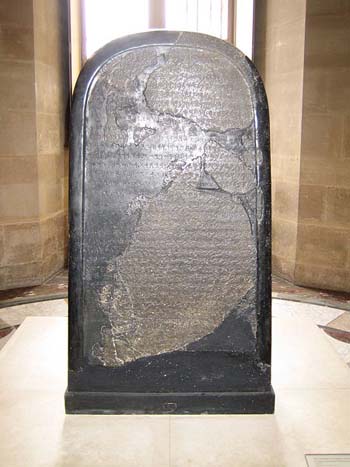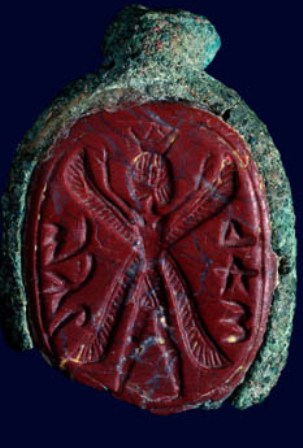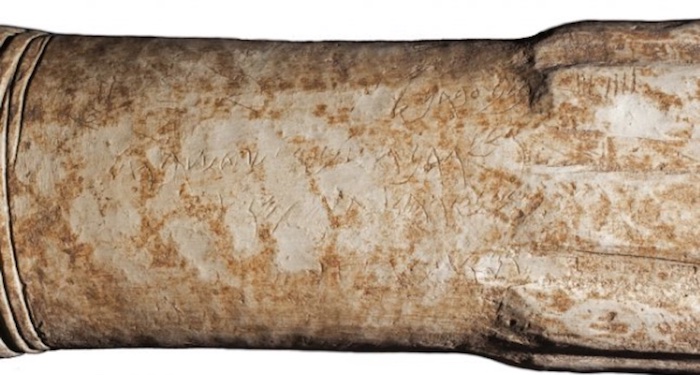Examples of writing
Moabite inscription from El-Kerak (first or second half of the 9th century BC)

l. 1: K]MŠYT MLK M′B HD[YBNY
l. 2: BBY]T KMŠ LMB‘R KY ′H[BTY
l. 3: ]NH WHN ‘STY ′T [
"K]mšyt, king of Moab, the D[ibonite
in the temple of] Kemoš in sacrifice, because [I loved
] and lo, I made ["
Unearthed in Jordan in 1958, this inscription was carved on gray-black basalt either by Meša himself or by his father Kemošyat, around the middle of the 9th century BC. The surface is carefully polished and wavy lines cover the bottom of the fragment; that led to the hypothesis that the inscription was carved on an expressly prepared panel, cutting in two the garment of some standing figure or image. Such a procedure does have parallels (compare, for example, the Aramaic funerary stone of Nerab in the 7th century BC). The finely carved writing, close to that of the Meša stone, shows the specific feature of a four lateral stroke H, found also in two seals from Sokoh and Gibeon. The text appears to be a celebrative one (a dedication?), listing and recalling the king's deeds in autobiographical style. Based on the analogies with l. 1 of the Meša stone, some scholars prefer to read ’NK MŠ‘ BN ("I am Meša, son of Kemošyat..."), before K]mšyt in l. 1.
Stone of Meša, king of Moab (second half of the 9th century BC)

Discovered in Dibon in 1868 by a German missionary, published two years later and now kept at the Louvre, the Meša stone reports in autobiographical style some military and building deeds of the king of Moab who managed to free that region of Transjordan from Israelite control in the second half of the 9th century. The bottom of the inscription ends abruptly and we don't know how long the text actually was. This stone offers the rare chance to test reliability and bias of the Biblical narrative, as it relates another version of the rebellion of Moab against the kingdom of Israel (see 2 Kings 3, 4-27). The two versions diverge in many, important details; the stone doesn't even mention the kingdom of Judah. On the linguistic level, some features deserve attention: the masculine plural ending -în, the 3rd person masculine suffix pronoun -h, instead of the common -w, the feminine absolute ending -t, and a reflexive, -t infixed verbal form (ll. 11.15.19.32), elsewhere attested only in Ugaritic, Accadian and, later, Arabic. The first two may be traced back to a north-Arabic origin, notwithstanding that they both appear also in Hebrew (the second one, it must be said, just in a late period and probably under the influence of Aramaic); the other ones appear to be lateral area archaisms. The correct translation and the interpretation of many points in the inscription are still under debate, most of all, the sequence ′R′L DWDH in l. 12 and the reading BT[.]WD in l. 31, which A. Lemaire restores with a further D and translates "House of David". This proposal has undergone many attacks and critiques, and other hypotheses of reconstruction have been advanced. Among them, G. Garbini's translation of DWD with "governor" deserves to be mentioned, based on the use of that root in Mesopotamian sources of the first half of the 2nd millennium BC.
Meša stone: transcription and translation

l. 1: ′NK MŠ‘ BN KMŠ[YT] MLK M′B HD
l. 2: YBNY ′BY MLK ‘L M′B ŠLŠN ŠT W′NK MLK
l. 3: TY ′ḤR ′BY W′‘S HBMT Z‘T LKMŠ BḲRḤH BN[
l. 4: Š‘ KY HŠ‘NY MKL HŠLKN WKY HR′NY BKL ŠN′Y ‘MR
l. 5: Y MLK YSR′L WY‘NW ′T M′B YMN RBN KY Y′NP KMŠ B′R
l. 6: ṢH WYḤLPH BNH WY′MR GM H′ ′‘NW ′T M′B BYMY ′MR K[
l. 7: W′R′ BH WBTH WYSR′L ′BD ′BD ‘LM WYRŠ ‘MRY ′T ′[R]
l. 8: Ṣ MHDBH WYŠB BH YMH WḤṢY YMY BNH ′RB‘YN ŠT
l. 9: BH KMŠ BYMY W′BN ′T B‘LM‘N W′‘S BH H′ŠWḤ W′B[N]
l. 10: ′T ḲRYTN W′Š GD YŠB B′RṢ ‘ṬRT M‘LM WYBN LH MLK Y
l. 11: ŚR′L ′T ‘ṬRT W′LTḤM BḲR W′ḤZH W′HRG ′T KL H‘M [M]
l. 12: HḲR RYT LKMŠ WLM′B W′ŠB MŠM ′T ′R′L DWDH W′[S]
l. 13: ḤBH LPNY KMŠ BḲRYT W′ŠB BH ′T ′Š ŠRN W′T ′[Š]
l. 14: MḤRT WY′MR LY KMŠ LK ′ḤZ ′T NBH ‘L YŚR′L W′
l. 15: HLK BLLH W′LTḤM BH MBḲ‘ HŠḤRT ‘D ṢHRM W′Ḥ
l. 16: ZH W′HRG KL[H] ŠB‘T ′LPN G[B]RN W[GR]N WGBRT W[GR]
l. 17: T WRḤMT KY L‘ŠTR KMŠ HḤRMTH W′ḲḤ MŠM ′[T K]
l. 18: LY YHWH W′SḤB HM LPNY KMŠ WMLK YŚR′L BNH ′T
l. 19: YHṢ WYŠB BH BHLTḤMH BY WYGRŠH KMŠ MPNY [W]
l. 20: ′ḲḤ MM′B M′TN ′Š KL RŠH W′Š′H BYHṢ ′ḤZH
l. 21: LSPT ‘L DYBN ′NK BNTY ḲRḤH ḤMT HY‘RN WḤMT
l. 22: H‘PL W′NK BNTY Š‘RYH W′NK BNTY MGDLTH W′
l. 23: NK BNTY BT MLK W′NK ‘ŚTY KL′Y H′ŠW[Ḥ BM‘]YN BḲR[B]
l. 24: HḲR WBR ′N BḲRB HḲR BḲRḤH W′MR LKL H‘M ‘ŚW L
l. 25: KM ′Š BR BBYTH W′NK KRTY HMKRTT LḲRḤH B′SR
l. 26: Y YŚR′L ′NK BNTY ‘R‘R W′NK ‘ŚTY HMSLT B′RNN W
l. 27: ′NK BNTY BT BMT HY HRS H′ ′NK BNTY BṢR KY ‘YN
l. 28: [H′] B[′]Š DYBN ḤMŠN KY KL DYBN MŠM‘T W′NK MLK
l. 29: T[Y ‘L H]M′T BḲRN ′ŠR YSPTY ‘L H′RṢ W′NK BNT
l. 30: Y [.. MHD]B′ WBT DBLTN WBT B‘LM‘N W′Ś′ ′T N[.]
l. 31: [........] Ṣ′N H′RṢ WḤWRNN YŠB BH B[...]WḲ[..]′Š[.]
l. 32: [........ WY]′MR LY KMŠ RD HLTḤM BḤWRNN W′RD W[′L]
l. 33: [TḤM BḲR W′ḤZH WYŠB] BH KMŠ BYMY W‘L[.]DH MŠM ′Ś[...]
l. 34: [mancano 29-31 lettere]T ŚDḲ W′N[K .]
l. 35: vacat
"I am Meša, son of Kemoš[yat], king of Moab,
from Dibon. My father ruled over Moab for thirty years, and I became king
after my father. I raised this altar to Kemoš in Qeriho (following Garbini; others translate: in the citadel), altar
of victory, because he rescued me from everyone assaulting me and made me look down upon the enemies who hated me. Omri,
king of Israel, had humiliated Moab for many days, since Kemoš was angry with his land.
his son ruled after him, and he too said: «I will humiliate Moab!», that he said in my days.
But I eventually looked down upon him and his family, and Israel was wiped out forever. Omri had conquered the land of
Madaba, and dwelled there in his days and for half the days of his son, forty years, but
in my days Kemoš settled there. I built Baal-meon anew, and dug a water reservoir there; so did I build again
Qiryaten. Since immemorial times had the men from Gad settled in the land of Atarot, and the king of
Israel had built Atarot for himself. I fought against the city and seized it, I killed all the inhabitants
to satisfy Kemoš and Moab. I took Ariel, the governor (following Garbini; others translate: the lion or altar of David), away, and dragged him
before Kemoš in Qeryot, and I settled there men from Šaron and
Maharot. Then, Kemoš told me: «Go and seize Nebo from Israel!». So I did:
I came at night and fought against it from daybreak till noon. I
seized it and killed everyone, seven thousand, men and women, foreigners,
and female slaves (or, according to Garbini, prostitutes), because I had devoted it to Aštar Kemoš. I took
YHWH's furnishings away and dragged them before Kemoš. The king of Israel had built
Yahas, and dwelled there as he fought against me, but Kemoš drove him out before me.
I took from Moab two hundred men, the whole contingent, and led them against Yahas. I seized the city,
and added it to Dibon. I built Qeriho, the wall of the forest and the wall
of the Ofel, I built its gates, I built its towers,
I built the king's palace, and the water mains for the reservoir at the centre of
the city. There was no cistern in the middle of the city, therefore I said to the people: «Let everyone of you have
a cistern in his home». I let the prisoners of Israel cut trunks for Qeriho.
I built Aroer, I built a road along the Arnon,
I built Bet Bamot anew (or, according to Garbini, the temple of the bamat), since it was destroyed, and Basar (or, according to Garbini, the fortress), since it was in ruins,
with fifty men from Dibon, because all Dibon obeys me. So I ruled
over hundreds of cities that I annexed to my territories. I built [...]
Madaba, Bet Diblaten and Bet Baal-meon, and I led there [...]
[...] the flocks of the land. In Horonen dwelled [...]
[...], and Kemoš said to me: «Go down and fight against Horonen!». I went down [and
fought against that city, and seized it], and in my days Kemoš dwelled there. As far as [...] is concerned, from there [...]
[...] and I [...]
Meša stone: the Tetragrammaton YHWH (l. 18)

YHWH
"YHWH"
Regardless of the Egyptian texts documenting the existence of "Š3sw Yhw" , nomadic tribes of the desert moving through Edom, Seir and Southern Transjordan, this is the first, assured mention of the Tetragrammaton-to-be, as the name of the national god of the kingdom of Israel.
Meša stone: the name of Omri, king of Israel (ll. 4-5)

‘MRY MLK YSR’L
"Omri, king of Israel"
The oldest mention of the name "Israel", after the one on the Merneptah stone (approximately 1208 BC).
Seal of Kmš′r (8th century BC)

To the left (from the bottom up): LKM
To the right (from the bottom up): Š′R
"(Belonging) to Kmš′r"
This scaraboid seal, mounted in bronze, bears the image of a winged human figure dressed with skirt. Egyptian influence is evident, as it is in contemporary and later seal manufacturing in Judah.
Seal of Kmšntn (7th century BC)

l. 1: KMŠ
l. 2: NTN
"Kmšntn"
This round, lapis lazuli seal bears the name of its owner, Kemoš-natan ("The god Kemoš gave"). Its unearthing in Ur may suggest that the man lived there; whether he settled in Ur as a merchant, as a deportee or as a descendant of deportees, is still unclear.
Cylindrical stone altar from Ataroth (9th-8th century BC),

Cylindrical stone altar of incense unearthed in 2010 in a cultural context at Khirbat Ataruz in Jordan. It contains seven lines of text in Moabite in two separate inscriptions, dated paleographically to the late ninth–early eighth centuries BC: the first one records small amounts of metal, maybe for cultural purposes, the second one is more mysterious and appears to be commemorative and/or dedicatory; both inscriptions make use of hieratic numerals.
Link to the excavations & surveys web site containing more images from the site and the fieldworks 2015-2019.